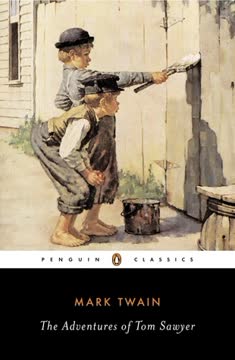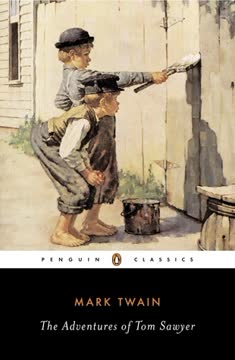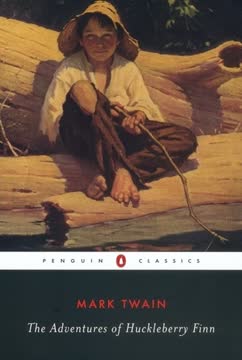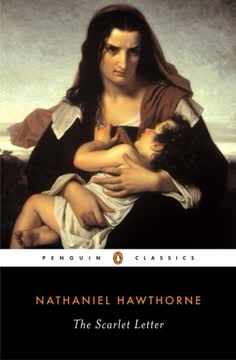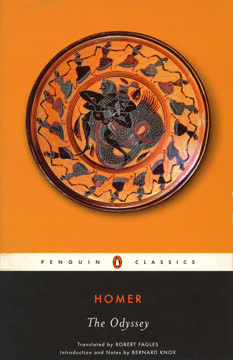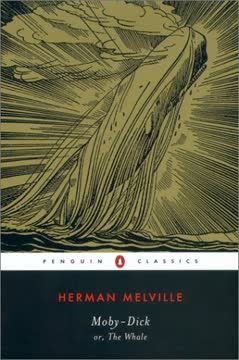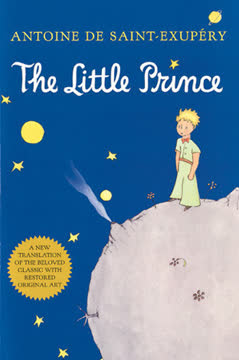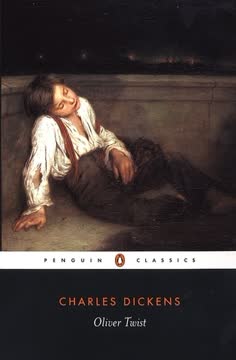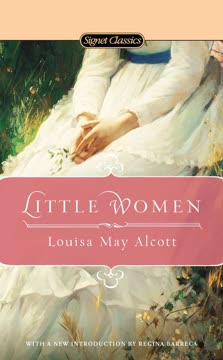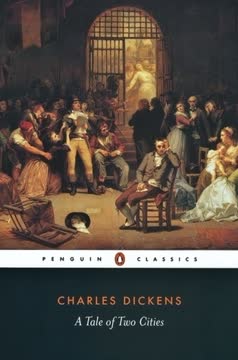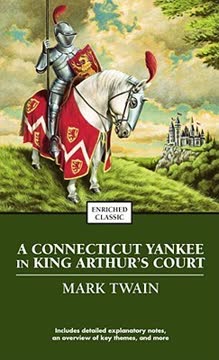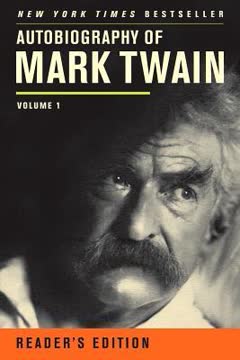Plot Summary
Mischief and Consequences
Tom Sawyer, a lively and mischievous boy, lives with his Aunt Polly in the small town of St. Petersburg. Constantly getting into trouble, Tom's antics often frustrate his aunt, who struggles between disciplining him and her affection for him. Tom's adventures include playing hooky from school, getting into fights, and tricking other boys into doing his chores. Despite his mischief, Tom is charming and clever, often finding ways to escape punishment.
The Whitewashing Scheme
When Tom is tasked with whitewashing a fence as punishment, he cleverly turns the situation to his advantage. By pretending that the task is enjoyable, he convinces his friends to do the work for him in exchange for small treasures. This episode highlights Tom's cunning nature and his ability to manipulate situations to his benefit, showcasing his resourcefulness and charm.
Tom's Heroic Deeds
Tom's adventurous spirit leads him to witness a murder in the graveyard, where Injun Joe kills Dr. Robinson. Tom and his friend Huck Finn swear to keep the incident a secret, fearing retribution from Injun Joe. Despite the danger, Tom's conscience eventually compels him to testify in court, leading to the arrest of the wrongfully accused Muff Potter. Tom's bravery earns him admiration and respect from the townspeople.
The Graveyard Witness
After witnessing the murder, Tom and Huck are haunted by fear and guilt. They make a blood oath to keep the secret, fearing Injun Joe's wrath. The boys' friendship deepens as they navigate the moral complexities of their situation, highlighting themes of loyalty and courage. Their pact becomes a pivotal moment in their lives, shaping their actions and decisions.
Treasure Hunt Begins
Inspired by tales of hidden treasure, Tom and Huck embark on a quest to find it. Their search leads them to a haunted house, where they overhear Injun Joe discussing a hidden stash of gold. The boys' excitement is tempered by fear, as they realize the danger of crossing paths with the murderous Injun Joe. Their treasure hunt becomes a thrilling adventure filled with suspense and danger.
Cave Adventures
During a picnic, Tom and Becky Thatcher, his love interest, become lost in McDougal's Cave. As they struggle to find their way out, they encounter Injun Joe, who is hiding in the cave. The experience tests Tom's bravery and resourcefulness, as he must find a way to protect Becky and escape. The cave adventure is a turning point for Tom, marking his transition from boyhood to maturity.
Justice and Redemption
Injun Joe is eventually found dead in the cave, having been trapped inside. Tom's testimony helps clear Muff Potter's name, and he is hailed as a hero. The treasure is discovered, bringing wealth to Tom and Huck. The story concludes with Tom's newfound maturity and sense of responsibility, as he contemplates future adventures with Huck. The themes of justice, redemption, and the triumph of good over evil are central to the story's resolution.
Characters
Tom Sawyer
Tom is the protagonist, known for his cleverness and love of adventure. He often finds himself in trouble but uses his wit to navigate challenges. His journey from a mischievous boy to a responsible young man is central to the story.
Huckleberry Finn
Huck is the son of the town drunkard and lives a carefree life. He is Tom's closest friend and partner in adventure. Huck's loyalty and bravery are evident throughout the story, and he plays a crucial role in the treasure hunt and the events in the cave.
Aunt Polly
Aunt Polly is Tom's guardian, who struggles to balance discipline with her love for him. She is often exasperated by Tom's antics but deeply cares for his well-being. Her character represents the moral and societal expectations of the time.
Becky Thatcher
Becky is the daughter of Judge Thatcher and Tom's romantic interest. She is adventurous and spirited, joining Tom in the cave exploration. Her relationship with Tom highlights themes of young love and innocence.
Injun Joe
Injun Joe is the story's primary antagonist, responsible for Dr. Robinson's murder. His presence looms over Tom and Huck, driving much of the story's tension. His eventual demise in the cave brings resolution to the story's conflict.
Muff Potter
Muff is a kind-hearted but simple man, wrongfully accused of murder. Tom's testimony ultimately clears his name, highlighting themes of justice and redemption. Muff's character evokes sympathy and represents the consequences of societal judgment.
Judge Thatcher
Judge Thatcher is Becky's father and a prominent figure in the town. He represents law and order and plays a role in Tom's eventual recognition as a hero. His character underscores the importance of justice and integrity.
Plot Devices
Adventure and Exploration
The story is propelled by Tom's love for adventure and exploration. From treasure hunts to cave explorations, these adventures serve as a backdrop for Tom's growth and development. The theme of adventure highlights the excitement and challenges of childhood.
Moral Dilemmas
Tom and Huck face several moral dilemmas, such as whether to reveal the truth about the murder. These dilemmas force the characters to confront their values and make difficult choices, driving their development and the story's themes of justice and redemption.
Superstition and Folklore
Superstition and folklore play a significant role in the story, influencing the characters' beliefs and actions. From treasure maps to haunted houses, these elements add depth to the narrative and reflect the cultural context of the time.
Analysis
"The Adventures of Tom Sawyer" explores themes of growth, justice, and adventure through the lens of childhood. Tom's journey from a mischievous boy to a responsible young man is marked by his adventures and moral dilemmas. The story highlights the importance of friendship, loyalty, and courage in the face of adversity. Twain's portrayal of small-town life and the innocence of childhood is both nostalgic and critical, offering a reflection on societal norms and values. The novel remains a timeless exploration of the complexities of growing up and the enduring spirit of adventure.
Last updated:
FAQ
Synopsis & Basic Details
What is The Adventures of Tom Sawyer about?
- Boyhood Escapades & Moral Growth: The novel chronicles the mischievous adventures of Tom Sawyer, an imaginative and spirited orphan living with his Aunt Polly in the fictional town of St. Petersburg, Missouri, along the Mississippi River. It follows his journey through childhood pranks, first love, and thrilling escapades.
- Confronting Adulthood's Shadows: Beyond lighthearted fun, the story delves into darker themes as Tom and his friend Huckleberry Finn witness a murder, leading them into a pact of silence, a terrifying secret, and a quest for hidden treasure. This forces Tom to grapple with his conscience and the harsh realities of the adult world.
- A Portrait of 19th-Century Americana: Twain paints a vivid picture of small-town life, blending humor, social satire, and adventure, exploring themes of freedom, conformity, justice, and the transition from innocent boyhood to a nascent understanding of responsibility and morality.
Why should I read The Adventures of Tom Sawyer?
- Timeless Exploration of Childhood: It offers a nostalgic and often humorous look at the universal experiences of youth, from playing hooky and first crushes to elaborate games of pirates and treasure hunting, resonating with anyone who remembers the boundless imagination of childhood.
- Masterful Storytelling & Characterization: Mark Twain's distinctive narrative voice, rich with wit and local color, brings to life unforgettable characters like the cunning Tom, the free-spirited Huck, and the conflicted Aunt Polly, making their triumphs and struggles deeply engaging.
- Deeper Social Commentary: Beneath the surface of adventure, the novel subtly critiques societal norms, religious hypocrisy, and the constraints of civilization, offering insights into human nature and the complexities of justice and freedom in 19th-century America.
What is the background of The Adventures of Tom Sawyer?
- Author's Childhood & Regionalism: Mark Twain (Samuel Clemens) drew heavily from his own boyhood experiences in Hannibal, Missouri, a river town that served as the model for St. Petersburg. The novel is a prime example of American regionalism, capturing the dialect, customs, and social dynamics of the antebellum South.
- Post-Civil War Reflection: Published in 1876, the novel looks back at a pre-Civil War era, offering a romanticized yet critical view of a simpler time, subtly touching upon issues like slavery (through characters like Jim) and the rigid social structures that would later be challenged.
- Literary Transition & Satire: Twain's work marks a shift in American literature, moving towards a more realistic and vernacular style. He uses humor and satire to comment on institutions like the church and school, and the often-hypocritical morality of adults, contrasting it with the more honest, if sometimes misguided, morality of children.
What are the most memorable quotes in The Adventures of Tom Sawyer?
- "Work consists of whatever a body is obliged to do, and that Play consists of whatever a body is not obliged to do." (Chapter 2): This quote encapsulates Tom's ingenious philosophy of human motivation, revealing his understanding of psychology and how perception shapes value, famously demonstrated in the whitewashing scene.
- "The less there is to justify a traditional custom, the harder it is to get rid of it." (Chapter 5): A sharp, satirical observation from Twain's narrator, this line critiques the blind adherence to societal norms and religious rituals, highlighting the irrationality often underlying established practices.
- "I could forgive the boy, now, if he'd committed a million sins!" (Chapter 19): Aunt Polly's emotional outburst after discovering Tom's sycamore bark note reveals the depth of her love and the profound impact of Tom's unexpected act of kindness, showcasing the power of genuine affection over strict discipline.
What writing style, narrative choices, and literary techniques does Mark Twain use?
- Vernacular Language & Humor: Twain masterfully employs colloquial speech and regional dialects, particularly for characters like Huck Finn, lending authenticity and humor to the narrative. His use of hyperbole and understatement creates a distinctive comedic tone.
- Omniscient, Satirical Narrator: The narrator is an all-knowing observer who frequently interjects with witty, often cynical, commentary on human nature, societal conventions, and the follies of adults, contrasting their perspectives with the unvarnished views of the children.
- Juxtaposition of Innocence and Darkness: Twain skillfully balances lighthearted boyhood adventures with moments of profound fear and moral gravity, such as the murder in the graveyard, creating a dynamic narrative that explores the complexities of growing up in a world that is both enchanting and dangerous.
Hidden Details & Subtle Connections
What are some minor details that add significant meaning in Tom Sawyer?
- Aunt Polly's Spectacles: In Chapter 1, Aunt Polly's "state pair" of spectacles are described as being "built for 'style,' not service," as she "seldom or never looked through them for so small a thing as a boy." This detail subtly reveals her vanity and her often superficial perception of Tom, suggesting she sees him through a lens of expectation rather than truly observing his actions or motivations.
- Tom's Whistling as an Escape Mechanism: After being caught for playing hooky in Chapter 1, Tom quickly forgets his troubles by practicing a "peculiar bird-like turn" in whistling. This seemingly trivial detail highlights his youthful resilience and his ability to find immediate solace and distraction in simple pleasures, a coping mechanism he employs throughout the novel to ward off deeper anxieties.
- The "Model Boy" as a Societal Critique: Willie Mufferson, the "Model Boy" (Chapter 5), is presented as excessively good and admired by adults, yet "the boys all hated him." This minor character serves as a satirical foil to Tom, embodying the artificiality of adult expectations for children and subtly critiquing the suppression of natural boyhood spirit in favor of superficial piety.
What are some subtle foreshadowing and callbacks in The Adventures of Tom Sawyer?
- Injun Joe's Unresolved Revenge: In Chapter 9, Injun Joe explicitly states his long-held grudge against Dr. Robinson, saying, "Five years ago you drove me away from your father's kitchen... and when I swore I'd get even with you... The Injun blood ain't in me for nothing." This detailed recounting of his past grievance foreshadows his later, more general "revenge" plot against the Widow Douglas, revealing a pattern of deep-seated, patient vindictiveness.
- The Cave as a Recurring Motif: McDougal's Cave is first mentioned casually as a local attraction for the picnic in Chapter 29, but its labyrinthine nature and potential for getting lost are emphasized. This early description subtly foreshadows its later role as both a terrifying prison for Tom and Becky and the final resting place for Injun Joe, transforming it from a place of innocent fun to one of life-or-death stakes.
- The "Dead Cat" Charm and Superstition: In Chapter 6, Huck and Tom discuss using a dead cat to cure warts and the belief that devils come for the wicked dead at midnight in the graveyard. This seemingly childish superstition directly leads them to the graveyard on the night of the murder, setting the stage for the central conflict and demonstrating how folklore can inadvertently guide characters into real-world danger.
What are some unexpected character connections in The Adventures of Tom Sawyer?
- Huck Finn and Muff Potter's Mutual Kindness: Despite their social standing, Huck reveals in Chapter 23 that Muff Potter "ain't no account; but then he hain't ever done anything to hurt anybody... he give me half a fish, once... and lots of times he's kind of stood by me when I was out of luck." This shows a deeper, reciprocal bond of compassion between the two outcasts, highlighting Muff's inherent goodness and Huck's capacity for loyalty, which ultimately influences Tom's decision to testify.
- The Widow Douglas's Unsung Hero: In Chapter 30, the Welshman reveals that the Widow Douglas was saved from Injun Joe's revenge by an unnamed individual, stating, "There's another that you're more beholden to than you are to me and my boys, maybe, but he don't allow me to tell his name." This anonymous hero is, of course, Huck, whose quiet act of courage connects him directly to the town's most respected figure, setting the stage for his reluctant adoption and integration into society.
- Tom's Unconscious Influence on Aunt Polly's Remorse: In Chapter 12, after Tom gives Painkiller to the cat, Aunt Polly reflects, "what was cruelty to a cat might be cruelty to a boy, too." This moment of empathy, triggered by Tom's mischievous act, reveals a subtle connection between her treatment of animals and her own conscience regarding her disciplinary methods, suggesting Tom's actions, even when naughty, can provoke self-reflection in adults.
Who are the most significant supporting characters in The Adventures of Tom Sawyer beyond the main cast?
- Mary, the Voice of Gentle Morality: Tom's cousin Mary (Chapter 4) consistently represents gentle kindness and conventional morality, often trying to guide Tom towards "goodness" without the harshness of Aunt Polly. Her quiet influence and unwavering affection provide a moral compass and a source of unconditional love that contrasts with the more transactional relationships Tom often navigates.
- Mr. Dobbins, the Frustrated Schoolmaster: The schoolmaster (Chapter 20, 21) is a figure of authority whose unfulfilled ambition to be a doctor makes him particularly severe and prone to petty tyranny. His character highlights the stifling nature of formal education and adult hypocrisy, serving as a target for the boys' revenge and a symbol of the oppressive forces Tom often rebels against.
- The Welshman, a Catalyst for Justice: Mr. Jones, the Welshman (Chapter 29, 30), initially appears as a minor character but becomes crucial in the climax. His willingness to listen to Huck's fragmented story and act decisively against Injun Joe demonstrates the importance of community and courage in upholding justice, bridging the gap between the boys' secret world and adult intervention.
Psychological, Emotional, & Relational Analysis
What are some unspoken motivations of the characters in The Adventures of Tom Sawyer?
- Tom's Craving for Recognition and Admiration: Beyond simple mischief, Tom is deeply motivated by a desire for public acclaim and to be the center of attention, whether it's through his whitewashing scheme (Chapter 2), his dramatic return at his own funeral (Chapter 17), or his chivalrous act for Becky (Chapter 20). His actions are often calculated to elicit awe, envy, or pity from his peers and adults.
- Injun Joe's Deep-Seated Social Resentment: While his revenge against Dr. Robinson is explicit (Chapter 9), Injun Joe's broader "revenge" plot against the Widow Douglas (Chapter 29) stems from a profound sense of social injustice and humiliation. His past "horsewhipped in front of the jail, like a nigger!" reveals a motivation rooted in racial and class oppression, making his villainy a tragic consequence of societal cruelty.
- Aunt Polly's Guilt and Desire for Affection: Aunt Polly's constant struggle between disciplining Tom and her underlying love (Chapter 1, 15, 19) is driven by a deep-seated guilt over her perceived failures as a guardian and a yearning for Tom's genuine affection. Her "conscience reproached her" when she wrongly punished him, and her tears over his supposed death reveal a profound emotional vulnerability beneath her stern exterior.
What psychological complexities do the characters exhibit in The Adventures of Tom Sawyer?
- Tom's Conscience and Moral Dilemmas: Tom frequently experiences intense guilt and fear, particularly after witnessing the murder (Chapter 10). His "fearful secret and gnawing conscience disturbed his sleep," leading to sleep-talking and physical ailments. This internal struggle between self-preservation and moral duty highlights the psychological burden of his secret and his developing sense of right and wrong.
- Huck's Fear of Civilization and Conformity: Despite gaining wealth and a home with the Widow Douglas, Huck experiences profound "sufferings" (Chapter 35) due to the constraints of civilized life. His longing for the freedom of his vagabond existence, where he could "swear wonderfully" and "never had to wash," reveals a deep-seated psychological aversion to societal expectations and a preference for untamed liberty over comfort.
- Becky Thatcher's Pride and Emotional Volatility: Becky exhibits a complex mix of pride, jealousy, and vulnerability. Her initial rejection of Tom after his blunder about Amy Lawrence (Chapter 7) and her subsequent use of Alfred Temple to make Tom jealous (Chapter 18) demonstrate a sophisticated emotional manipulation. Her terror and gratitude during the cave ordeal (Chapter 31) reveal her dependence on Tom and the depth of her feelings.
What are the major emotional turning points for Tom Sawyer?
- The Graveyard Murder and Blood Oath (Chapter 9-10): Witnessing the brutal murder and making a blood oath with Huck is a profound emotional turning point. It shatters Tom's innocent view of the world, replacing carefree mischief with paralyzing fear and a heavy burden of guilt, forcing him to confront mortality and moral responsibility.
- His Own Funeral (Chapter 17): Overhearing his own funeral sermon, filled with eulogies and the genuine grief of Aunt Polly and Becky, profoundly impacts Tom. The "proudest moment of his life" is tinged with the realization of how much he is loved, shifting his perspective from seeking attention to appreciating the emotional bonds he shares.
- Injun Joe's Death in the Cave (Chapter 33): Discovering Injun Joe's starved body in the cave brings Tom a complex mix of "relief and security" alongside pity. This moment marks the definitive end of his terror and the resolution of his deepest fear, allowing him to fully embrace his newfound heroism and move towards a more secure future.
How do relationship dynamics evolve in The Adventures of Tom Sawyer?
- Tom and Becky: From Infatuation to Mutual Respect: Their relationship begins with childish flirtation and Tom's "showing off" (Chapter 3), marked by jealousy and misunderstandings (Chapter 7, 18). However, their shared ordeal in the cave, culminating in Tom's chivalrous act of taking Becky's whipping (Chapter 20) and his protective care during their entrapment (Chapter 31), transforms their bond into one of deeper affection and mutual reliance.
- Tom and Huck: From Playmates to Brothers in Arms: Their friendship, initially based on shared mischief and a mutual admiration for each other's "outcast" status (Chapter 6), deepens significantly through the shared secret of the murder (Chapter 10) and the treasure hunt (Chapter 25). Their loyalty is tested and solidified by these life-threatening experiences, culminating in a partnership that transcends social boundaries and forms the core of their adventures.
- Tom and Aunt Polly: From Conflict to Understanding: Their dynamic is characterized by a constant push-and-pull between Tom's rebellious nature and Aunt Polly's attempts at discipline, often laced with her "dark and mysterious diplomacy" (Chapter 1). Over the course of the novel, particularly after Tom's "dream" confession (Chapter 18) and his return from the cave, Aunt Polly's love and understanding for Tom deepen, moving beyond mere duty to a more profound, albeit still exasperated, affection.
Interpretation & Debate
Which parts of the story remain ambiguous or open-ended?
- Huck Finn's Future in Civilization: The novel concludes with Huck reluctantly agreeing to return to the Widow Douglas for a month to become "respectable" so he can join Tom's robber gang (Chapter 35). This ending leaves his long-term fate ambiguous, questioning whether he can truly adapt to societal constraints or if his innate desire for freedom will ultimately lead him back to his vagabond life, a theme explored further in Huckleberry Finn.
- The True Nature of Tom's "Dream": In Chapter 18, Tom recounts his "dream" of Aunt Polly's conversation, which is actually a clever fabrication of what he overheard. While Aunt Polly believes it to be a miraculous prophecy, the narrative leaves it open to interpretation whether Tom's act is purely manipulative or if it stems from a subconscious desire to comfort his aunt, blurring the lines between deceit and genuine affection.
- The Long-Term Impact of the Treasure on Tom and Huck: While the boys become rich, the novel only briefly touches on the immediate effects of their wealth (Chapter 35). It raises questions about how this sudden fortune will shape their characters and future choices, particularly for Huck, who finds wealth to be a burden rather than a blessing, hinting at the corrupting influence of money.
What are some debatable, controversial scenes or moments in The Adventures of Tom Sawyer?
- The Portrayal of Injun Joe: Injun Joe is depicted as a purely malevolent "half-breed" driven by revenge, with little exploration of his humanity or the systemic injustices he might have faced. His characterization has been debated for its potential to perpetuate racial stereotypes, presenting him as an almost archetypal villain without complex motivations beyond his "Injun blood" (Chapter 9).
- Tom's Deception of Aunt Polly with the "Dream": Tom's elaborate "dream" (Chapter 18) where he pretends to have foreseen the events of his funeral, while actually having overheard them, is a moment of significant moral ambiguity. While it brings Aunt Polly immense comfort, it is built on a calculated lie, prompting debate about whether Tom's actions are ultimately kind or manipulative, and how Twain intends readers to view this deception.
- The Treatment of Jim, the "Colored Boy": Jim, Aunt Polly's slave, is depicted in Chapter 1 as doing "three-fourths of
Review Summary
The Adventures of Tom Sawyer is widely regarded as a classic American novel, praised for its humor, portrayal of childhood, and memorable characters. Many readers appreciate Twain's storytelling and the nostalgic depiction of youth. Some find the language and themes dated, while others see it as a reflection of its time. The book is often compared to its sequel, Huckleberry Finn, and is considered an essential part of American literature. Readers enjoy the adventures, mischief, and coming-of-age themes present throughout the story.
Adventures of Tom and Huck Series
Similar Books
Download PDF
Download EPUB
.epub digital book format is ideal for reading ebooks on phones, tablets, and e-readers.
